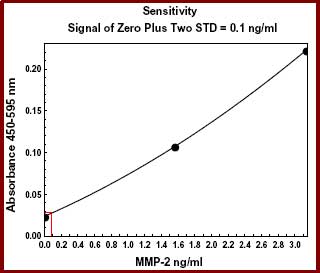QIA63 Sigma-AldrichMMP-2 ELISA Kit
Sinónimos: Gelatinase A ELISA Kit, 72 kDa Gelatinase ELISA Kit, Matrix Metalloproteinase 2 ELISA Kit
Productos recomendados
Descripción
| Replacement Information |
|---|
Tabla espec. clave
| Species Reactivity | Detection Methods |
|---|---|
| H | Colorimetric |
| References |
|---|
| Product Information | |
|---|---|
| Detection method | Colorimetric |
| Declaration | Not available for sale in Japan. |
| Form | 34 or 41 Tests |
| Format | 96-well plate |
| Kit contains | Anti-MMP-2 Coated 96-Well Plate, MMP-2 Standard, Detector Antibody, 400X Conjugate, Conjugate Diluent, Substrate, Sample Diluent, Plate Wash Concentrate, Stop Solution, Plate Sealers, and a user protocol. |
| Quality Level | MQ100 |
| Applications |
|---|
| Biological Information | |
|---|---|
| Assay range | 1.56 - 50 ng/ml |
| Assay time | 5.5 h |
| Sample Type | Tissue culture medium, serum, or plasma |
| Species Reactivity |
|
| Physicochemical Information | |
|---|---|
| Sensitivity | 0.1 ng/ml |
| Dimensions |
|---|
| Materials Information |
|---|
| Toxicological Information |
|---|
| Safety Information according to GHS |
|---|
| Product Usage Statements | |
|---|---|
| Intended use | The Calbiochem® MMP-2 ELISA Kit is a non-isotopic immunoassay for the in vitro quantitation of human MMP-2 protein in tissue culture medium, serum, and plasma. |
| Packaging Information |
|---|
| Transport Information |
|---|
| Specifications |
|---|
| Global Trade Item Number | |
|---|---|
| Número de referencia | GTIN |
| QIA63 | 0 |
Documentation
MMP-2 ELISA Kit Ficha datos de seguridad (MSDS)
| Título |
|---|
MMP-2 ELISA Kit Certificados de análisis
| Cargo | Número de lote |
|---|---|
| QIA63 |
Folleto
| Cargo |
|---|
| Kit SourceBook - 2nd Edition EURO |
| Kits SourceBook - 2nd Edition GBP |























